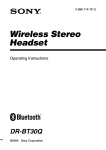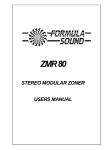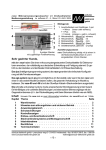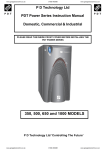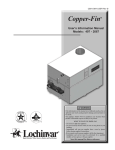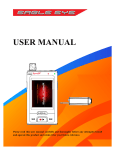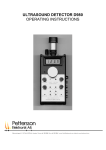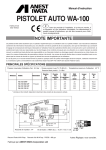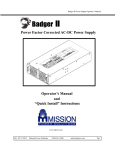Download Product Manual - Formula Sound
Transcript
SENTRY MK2 SOUND LEVEL CONTROL USERS MANUAL Sentry MK 2 ENVIRONMENTAL NOISE CONTROL SYSTEM FUNDAMENTALS Noise nuisance legislation requires sound levels to be controlled within limits, for licensed premises it is increasingly a condition of licensing that equipment to control sound levels is in place. Where artists (such as DJ’s or Bands) bring in their own sound equipment the only way to control sound levels is to control the mains power ring used for the sound equipment. Installing a contactor into the mains power ring (requires qualified electrician) used to supply power to the sound equipment and using a Sentry MK2 to monitor sound levels and control the contactor provides control of maximum music levels. The Sentry is designed to monitor sound levels and provide a trigger when a preset sound level is exceeded, this trigger will normally be used to trip a contactor removing the mains power supply to the music system. When the Sentry trips the contactor there is a short (about 3 seconds) delay before the system can be reset, before pushing the reset button always check that it is safe to do so (eg amps turned down so no sudden surge). The Sentry should be mounted opposite the performing area where the performers can see it. It should be mounted on a solid wall away from doors and some distance from where speakers will be mounted. If the Sentry is to be mounted on a wooden or plasterboard wall an external microphone is likely to be required as wooden/plasterboards are prone to vibration which will be picked up by the internal microphone. In a basic installation a permanent power feed is required to the Sentry which then supplies the control voltage to the contactor to hold it in, when the sound level exceeds the set level for about 10 seconds or more the Sentry triggers the removal of the control voltage to the contactor. The contactor opens and the mains supply to the music system is removed. If you are using our Contactor use the low voltage output from the Sentry which is the first two terminals on the grey connectors. You can use thin low voltage cable (bell wire alarm cable etc) the current requirement is very low, this connects to the two terminals on the printed circuit board located at the end of the contactor case. The polarity is not critical. DO NOT CONNECT MAINS INTO THE PRINTED CIRCUIT BOARD CONNECTORS WITHIN THE CONTACTOR CASE. When power is applied to the Sentry the reset light will be lit and no contactor control voltage will be present. Resetting the unit will cause the light to go out and the contol voltages to be present. The allowable noise level must be adjusted on site by using the multi turn pre-set labelled ADJ 1 at the bottom left of the circuit board usually 1-2 turns up or down from the factory setting will provide more than enough adjustment for most applications. The Sentry can have two levels set; if for example; the allowed level is different for day and night or weekdays/weekends then a switch (or timer) may be used to change to a second setting. 2 Sentry MK 2 ENVIRONMENTAL NOISE CONTROL SYSTEM Features A choice of internal microphone (supplied factory fitted as standard) or external microphone (with or without phantom power) may be selected. External microphone not included. A choice of weighting filters (A, C, BASS) or no weighting filter (LIN) Two sound level thresholds may be set, level 1 (default) and level 2. Switching from level 1 to level 2 can be done on a switch or a timer Security loop (eg for fire alarm or fire doors) Anti-tamper microphone circuitry is incorporated with a front panel indicator. Dual mains voltage operation is standard (internally switchable) Case provides easy connections via cable entry knock-outs and screw terminals Fire alarm interface Pair of isolated relay contacts Large display plus ability to power mains 60W warning light Will drive low voltage or mains contactor Slave display option Remote reset option (push button or keyswitch) Factory set to about 20 seconds just over limit before tripping AT1 option allowing sound levels to be controlled. General Detail Any function that can be controlled by a relay or switch can be controlled by the Sentry. These may include disconnecting loudspeakers, switching passive attenuators to reduce system volume or acting as the trigger into an active attenuator system as well as operating a contactor to remove the power supply. The Sentry may also be used as a stand alone display unit indicating sound pressure levels or in industrial applications to switch on warning lamps or illuminated signs advising the use of ear defenders when the safe noise level is exceeded. Our technical department is always on hand to advise when unusual applications are encountered. 3 Operation The Sentry features a large bar-graph VU meter with 23dB range to give a good visual indication of the noise level in a venue. While the meter is operating in the green section, with even an occasional peak into the red, there is no cause for concern. Factory set the Sentry has about 20 seconds delay when limit is just exceeded before power is removed to allow performers time to reduce sound levels. The Sentry will operate within the range 80dB - 120dB and may be pre-set to anywhere in this range. Provision is included to operate at 2 different levels, for instance at different times of day. This selection can be performed manually or automatically by a time switch. A front panel indicator shows when level 2 is selected. If a mains warning lamp is connected it will operate at the same point as the two red sections of the meter. These are labelled "WARNING". If the noise level is high enough to light the "OVER LIMIT" section of the meter (three red sections) the noise has exceeded the allowable limit. If this is allowed to continue for more than the set time period (about 20 seconds factory set) the unit will trip and remove the power to the contactor or relay. Visual indication of this is provided above the reset button. When the unit is first powered up the RESET indicator will be lit - wait for a few seconds and press the reset button. The Sentry will now be reset and ready for normal operation. The action of the timing circuit means that continually exceeding the limit even for short periods may eventually trip the unit. The unit has to be manually reset to restore power and this will only be possible after a short time. The reset time is determined by the amount by which the unit is driven over limit. e.g. tripping the unit by just exceeding the limit will result in a short period of a few seconds before reset is possible. Tripping the unit by grossly exceeding the limit will require a longer period before reset is possible. NOTE. It is important that a check is made before the unit is reset. Check that it is safe to do so (eg are amps turned down). Audio systems generally need to be powered up in a specific order. In an audio system comprising of different components amplifiers, mixers, etc. a general rule is to switch power amplifiers off first and on last to avoid possible loudspeaker damage. Therefore a band or D.J. may need to turn off amplification equipment to protect loudspeakers before the power is restored. All connections and adjustments are located beneath the removable cover plate (below the display). Non reusable security labels are supplied with each unit to help detect unauthorised tampering. Level 2 Level 2 is selected by shorting the 2 marked terminals on the Sentry grey connector strip. Switch may be via switch or relay etc, the timer option is detailed below. The allowed level at weekends or evenings may be different so the level 2 facility allows a quick switch. Opening windows and/or doors allows more sound out of a venue, setting level 1 about 6dB lower than level 2 and using magnet relays on doors/windows as the level 2 switch means running at level 2 (louder) as long as doors/windows shut and dropping to level 1 if opened. 4 Remote reset options Remote reset controls are available in either push button or keyswitch format, the reset control can then be mounted as desired eg behind the bar or in the managers office. Mic Tamper With Int(ernal) mic(rophone) selected the internal microphone is monitored for tampering, if Ext(ernal) mi(crophone) is selected the external microphone is monitored for tampering. A front panel LED indicator will show MIC TAMPER if the microphone has been tampered with and the Sentry will trip the contactor, the Sentry will not reset until MIC TAMPER indicator is off. If Mic tamper is illuminated with Internal microphone selected the internal microphone is probably damaged and you will need to contact your installer or Formula Sound. The Sentry will switch off if the Mic tamper or Security loop indicators are illuminated. Security loop The security loop feature is provided on two terminals behind the removable cover plate, while the two terminals are linked the Sentry will operate but if the link is broken (for more than half a second) the Sentry will trip. This feature can be used as in any circumstance that the Sentry is required to be tripped, eg fire doors can be fitted with a magnetic relay so that if the fire doors open the relay breaks the circuit and the Sentry is tripped. A front panel LED indicator will show SECURITY LOOP if the link between the two terminals is broken and the Sentry will trip the contactor, the Sentry will not reset until the link is restored (LED indicator off). Time levels exceed limit before the Sentry trips The period of time that noise "over limit" is tolerated before the unit trips out is variable over the range of 10 - 70 seconds. A pre-set is provided to adjust this should it be necessary - the factory setting is approx. 20 seconds. Fire alarm interface The fire alarm interface option allows the Sentry to be interfaced to a fire alarm, the interface can be set to accepted a trigger of voltage applied (up to 24V), voltage removed, contacts closing or contacts opening. Factory setting is “voltage applied”. Isolated contacts A pair of relay contacts that are normally open and close when the unit trips allow other equipment to be switched if required (contacts can be normally closed if required). 5 Timer option A timer option is available allowing the setting of two different levels at different times of the day or week. The timer may for example be set to switch to level 2 at 11pm which may be a quieter level. This option is factory fitted, although an external version will be available in the near future, contact Formula Sound for details. Counter option The counter option counts the number of times the Sentry has tripped. This option is factory fitted. 6 Mounting Position The Sentry should be mounted on a flat solid surface preferably where it can be seen by the persons affected by its use (D.J., band, etc.) and away from doors. It should be located in a position where it cannot be tampered with, e.g. A minimum of 8 feet (2.5 metres) from the floor, ideally on a wall facing the sound source. It is not necessary to have a microphone suspended above the band or dance floor. If the Sentry can hear the sound source above the background noise the unit can be calibrated accordingly. Avoid positions that are too close to the sound source e.g. in a typical concert room with the stage area at one end the Sentry should be positioned centrally away from the stage at a minimum distance equal to the stage width. If there is more than one source of sound, e.g. several instruments in a band the Sentry should ideally be at a position equal distance from each instrument. (see Fig1) Ideal Position w “A” “W” x Sentry Stage At least 2.5m From Floor level y z Fig 1 Distance “A” should never be less than distance “W”. Poor Positioning W X Stage Position (B) Y Sentry Sentry Z Better position Poor position Fig 2 In Fig 2 the instruments Y & Z will appear louder to the Sentry than instruments W & X. Moving the Sentry back away from the stage to position (B) will minimise the problem In order to help solve difficult location problems provision is now included to connect a remote microphone to the Sentry MK2. See Drg No 879 for more details. 7 Cable Entry and Fixing Read this section fully before proceeding Customising the box. Cable entry knock outs are provided on the rear and bottom faces of the unit, using the rear cable entry’s can result in a very neat installation. Select the cable entry positions to be used and remove the appropriate knock outs. (A small flat blade screwdriver on the perimeter of the hole will assist prizing out the blanking plugs.) Remove any sharp edges that may damage cables or use protective grommets (not supplied) NOTE: - Use a separate cable entry for mains connections. Always keep low voltage cables away from mains cables and connections. Fastening the unit. The unit is secured to a wall by 3 screws (not supplied). The top centre screw locates in a key hole slot on the back of the unit. The Sentry will require a mains power supply that is not controlled by the contactor, this should be in place before fastening the unit to the wall. Use No. 10 or 12 screws with round heads 1.5" (38mm) minimum length. Brick or masonry walls will require drilling and plugging in the usual manner. First remove the cover below the display to expose the bottom mounting screw holes, these are located in the bottom corners of the case. Fit the top centre screw 30 mm down from the required top case position, leave this screw approx. 1.5mm proud of the mounting face. The unit may now be suspended on this screw while the two bottom mounting screw positions are marked out (ensure that the unit is captive on the screw head so it cannot fall). Fit the bottom two mounting screws. Check that the unit is secure, cannot fall, and is not loose on the screws. In high risk areas security screws should be utilised to prevent the unit from being removed. Wiring For Applications Controlling the Mains Power. All mains wiring must be installed in accordance with IEEE Regulations. If after reading these instructions you are not sure how to proceed you should seek help from a qualified electrician. Overview The Sentry provides outputs to control a contactor or relay which in turn will control the mains supply. This strategy allows the Sentry to be mounted in the most suitable position for noise measuring whilst the mains switching equipment (the relay or contactor) can be mounted in the most convenient position for switching the mains power (fuse cupboard, etc). A 32amp fully fused boxed contactor with low voltage interface has been designed for use with the Sentry and is available from Formula Sound Ltd. The Sentry also provides connections to use a mains coil contactor with a maximum coil consumption of 60VA. 8 Installation In the room that is to be controlled identify all mains sockets and establish which mains ring (or rings) they are on. Select and install a suitable contactor in that mains ring, if there is more than one ring you will require as many contactors as there are rings. Ensure the contactor is adequate for the power rating of the ring(s). A 32amp fully fused boxed contactor with low voltage interface has been designed for use with the Sentry and is available from Formula Sound Ltd, also a dual version is available from Formula Sound which will control two 32 amp rings. In very large installations, it is a simple matter to make 1 contactor control many others of whatever current rating is required. Connect the contactor control back to the Sentry using appropriate cable and connections depending on the type of contactor used. Connections All connections to the Sentry are located beneath the lower removable front cover (below the display). On this cover is also mounted the reset button which connects to the printed circuit board via a 2 pin plug (and temporarily may be easily disconnected). See Drg No 879.for more details. Connect the Sentry to a suitable mains outlet using the terminals labelled “Mains In” and ensure that the earth is also connected. The mains consumption is approximately 1 amp at 240V - a 5 amp lighting feed could be utilised. Connect via an isolating switch or removable plug socket arrangement so that the unit can be isolated when necessary. For use on 120V the consumption will be approximately 2amps ENSURE THAT THE MAINS SUPPLY IS NOT THE SAME AS THAT CONTROLLED BY THE CONTACTOR. Warning Lamp Provision to switch a mains warning lamp to a maximum of 60VA is provided. The lamp can be of any style considered suitable but must have a maximum consumption of 60VA (60 watts). It is connected to the mains outlet terminals labelled "warning lamp". Alternatively a relay or contactor may be used to switch other lamps as required. Good wiring practice should be observed. Remote Reset Detail on page 12 Setting the Permissible Volume Level Adjustment of allowable noise level is made by adjusting the pre-sets ADJ 1 and ADJ 2. These are located beneath the removable cover at the left hand end of the unit. They are 10-turn pre-sets to provide fine adjustment. ADJ1 sets the normal operating level, ADJ 2 sets the level for a second threshold (Level 2) which can be initiated remotely. An indicator on the front panel will show when level 2 is selected. Take care when making adjustments and use a small screw driver. Try to make 9 adjustments when the noise level is displayed on the bar graph meter as you will be able to see the changes displayed on the meter. The adjustment pre-sets have a slipping clutch at the end of travel to prevent damage. But this can cause confusion if the pre-set is at the end of travel as it then appears to do nothing (this is not usually a problem once you know about it). The actual sound pressure level (SPL) at which the unit operates can only be determined by measuring the noise level using a calibrated sound pressure level meter and adjusting the unit accordingly. Play music at the maximum required level (monitor with SPL meter) and adjust ADJ1 so the “LIMIT” LED’s (right hand of display) are going on and off. A small increase in the music level will now trip the system after about 20 seconds, level 1 is now set. Repeat for level 2 if the second level is also to be used. Alternatively the unit may be adjusted using trial and error but this should be used only as a temporary measure or last resort. Measuring the sound level and setting to a limit agreed with the local area official is the only recommended method. An internal measuring microphone is fitted which will be suitable for most applications but should the need arise an external microphone can be connected. The external microphone may be a moving coil type, capacitor or electret. Microphone phantom power is provided and may be selected as required. Select a microphone with the required frequency response and polar response. (Please telephone our technical department if help is required). NOTES:- If the unit is to be used in an entertainment venue to control a band or disco use a meter with either a linear scale or 'C' weighting response. The frequency response of the measuring circuit of the Sentry may be selected to be, Linear (Flat response) ‘C’ (conventional C scale), Bass (LP filter @ 300Hz 12dB per octave slope) or A weighting. see Drg No 879. 'A' weighting is a frequency response curve that resembles the human ear response. It is much more sensitive in the mid 500Hz - 5 kHz region. It is not recommended for entertainment venues as it is less sensitive to the bass regions and bass regions travel most and annoy neighbours more. Most industrial applications will need A weighting. SECURITY LABELS ARE PROVIDED. THESE SHOULD BE FITTED TO COVER THE SCREW HEADS HOLDING THE REMOVABLE COVER IN PLACE AND WILL REVEAL ANY UNAUTHORISED ATTEMPT TO CHANGE THE THRESHOLDS ALWAYS FIT SECURITY LABELS AFTER ADJUSTMENTS HAVE BEEN MADE. EXTRA LABELS ARE AVAILABLE FROM FORMULA SOUND IF REQUIRED. Remember that the acoustic characteristics of a venue will change depending on the number of people in it. Our experience has shown that it is always advisable to take readings when the venue is in use. It would be a wise precaution to allow in your costings for a site visit during opening hours to take measurements and make final adjustments. 10 Security Loop Provision to connect a security loop is provided. This may be required for fire doors/alarm or emergency cut off etc. Magnetically operated reed switches of the type used in intruder alarms are most convenient for this application on doors or a simple emergency switch. If this facility is not required a wire link must be connected to allow the Sentry to work normally. (see Drg No 879). A front panel indicator shows if the security loop is opened. Tampering If you find that you have problems with unauthorised persons security screws are available to replace the cover retaining screws, a special key is also supplied for the fitting and removal of these screws. Contact FORMULA SOUND sales office for more details. Internal Settings Several optional settings are available internally. These are shown on drawing Drg No 879. Internal/External Microphone Selection and Phantom power This is accomplished by the position of three jumper plugs on pin headers. Take care to move jumpers and ensure that they connect correctly. The positions are shown on drawing Drg No 879. Weighting Selection The position of jumper plugs select the response on the measuring microphone. The positions are shown on the P.C.B. Ensure that the jumpers are seated correctly. Special weighting options are possible - contact Formula Sound for further details. External Microphone connection A 3 way terminal strip is provided for the connection of a remote microphone. The microphone should be low impedance, balanced and good quality twin screened cable should be used for the connections. Contact Formula Sound if you are unsure. Led Indicators Outputs are provided for remote led indicators: - MIC TAMPER, LEVEL 2, WARNING, RESET REQUIRED. If more than two leds are to be connected they share a common terminal. Led current limiting resistors are not required. Leds may be connected directly. These outputs are also sufficient to drive a contactor with low voltage interface if required. Timer Adjustment The period of time that noise "over limit" is tolerated before the unit trips out is variable over the range of 10 - 70 seconds. If adjustment is required locate the timer pre-set from Drg No 879 and adjust with a small terminal screwdriver as required. You may have to wait up to 70 seconds for the timing capacitor to discharge before new timer settings will take place. 11 Fire alarm interface The fire alarm interface jumpers setting the mode of operation are located beneath the display panel. To access first switch off power to the unit, open the perspex display cover and remove the screws from the display panel. Drop the display panel forward a couple of inches and reach in to release the ribbon cable connector attaching the display assembly to the main unit. The fire alarm interface connector and settings are located top right corner, on the PCB there is a legend “FIRE ALRM”. To set the mode of operation first set the jumpers for voltage sensing or contacts sensing (“VOLTS SENSE” and “CONT SENSE”). If the fire alarm is applying or removing a voltage then set for “VOLTS SENSE”, if the fire alarm is closing or opening contacts set for “CONT SENSE”. If voltage sensing is selected next set voltage applied or voltage removed (“V.A” or “V.R.”). If contact sensing is selected set for contacts normally closed or contacts normally open (located by legend “CONTACTS” and “N.C.” or “N.O.”). Replace the display, the ribbon cable connector is keyed so ensure it goes it the correct way round (if you feel any resistance when pressing home the connector it may be in the wrong way round). Switch the Sentry on and reset it, perform a fire alarm test to ensure the Sentry trips when the fire alarm operates. Remote Reset A remote reset facility can be added by connecting a momentary action push button or key switch. Site this in a Manager's office or behind the bar or other suitable location. Formula Sound offer both remote push button (074P) and remote keyswitch (074K) options in a grey plastic lighting style surface mount box. Connection of either 074P or 074K is as follows: Open the remote reset box and the connections are on the back of the front panel as shown below. LED COMMON -VE RESET REQUIRED LED +VE WARNING LED +VE RESET SWITCH The box contains LED’s that show if the Sentry is tripped (reset required) or if the sound level is near the limit (warning). Behind the panel below the main display is a grey connector strip (see drwg 879 later in manual). To connect LED’s and switch a 5 core wire is required (low voltage dc and low current), a 6 core microphone cable would be suitable. Connect the “RESET SWITCH” terminals to the Sentry terminals marked “N” (Remote reset switch) on drwg 879. 12 Connect the LED terminals to the Sentry terminals marked “J” (LED INDICATORS) on drwg 879, note LED COMMON is connected to the Sentry terminal marked “EARTH”. Contactor Details of the contactor are shown on drawing 755 towards the back of the manual. AT1 option An optional add on is available which can manage sound levels, the AT1 connects to the Sentry and provided the audio is signal is routed through the AT1 before going to the system amplier(s) the Sentry and AT1 will control levels just below the threshold that the Sentry has been set to. Remote display option A remote display option is available, this is mounted in an identical box but contains only the Sentry display circuitry and connects to the “Slave display” terminals. 13 Summary The Sentry will monitor sound levels and provide a trigger when a set sound level has been exceeded for about 20 seconds, typically the trigger will be used to operate a contactor. In an audio application (music) the Sentry will normally be used where performers bring in their own equipment, the mains power supply for this equipment will be put under the control of the Sentry by means of a mains contactor. Where mains power is to be controlled the mains ring(s) are identified and a contactor(s) are installed (by a qualified electrician) to control those rings. In an industrial application the Sentry may be used to indicate ear defenders are required or remove power to a piece of machinery, An “A” weighting filter will often be used in this situation. The Sentry should be mounted on a solid wall, away from doors and opposite the source of the sound. The display should be visable to performers or machine operators. If the Sentry cannot be mounted on a solid wall away from doors then an external microphone can be used. Two levels may be set (eg day and night or weekdays and weekends may require different levels), switching between levels may be done by switch, keyswitch or timer. There is a choice of filters, for music either Linear or Bass will be used (Bass tends to travel and therefore is a greater cause of noise nuisance) and for industrial “A” weighting should be used. The fire alarm interface allows the Sentry to be interfaced with the fire alarm. The security loop may be used to trip the system if fire doors are opened. Adding a Formula Sound AT1 to the Sentry can allow the music level to be controlled providing the music can be routed through the AT1 beofre going to the amplifiers. A simple method of setting the level for a music venue is to play music at the maximum allowable level (ensure speakers are where visitors will place them), the maximum allowable level is determined by the environmental health officer but will typically be either a level just audible in a neighbours premises or a set level at the boundary of the premises. With the music at the maximum allowable level adjust the Sentry (Adj 1) to be between “warning” and “Over limit” on the display. Note: Reducing the amount of sound escaping from a venue will generally increase the sound level the venue is allowed to operate at, doors, windows, direction and mounting of speakers all affect sound levels from a venue. FORMULA SOUND LTD. UNIT 23; STADIUM BUSINESS CENTRE NORTH END ROAD WEMBLEY MIDDLESEX HA9 0AT TEL: 44 (0) 208 900 0947 FAX: 44 (0) 208 903 8657 Email [email protected] www.formula-sound.com 14 FORMULA SOUND LIMITED UNIT 23; STADIUM BUSINESS CENTRE; NORTH END ROAD; WEMBLEY; MIDDLESEX; HA9 0AT TELEPHONE +44 (0)208-900-0947 FAX +44 (0)208-903-8657 www.formula-sound.co.uk email [email protected] E.U. CERTIFICATE OF CONFORMITY We declare that the products listed conform to the following directives and standards 89/336/EEC amended by 92/31/EEC and 93/68/EEC BS EN 50082-1 BS EN 50081-1 PRODUCT TYPE SENTRY MK2 The CE mark was first applied in 1995 Signed B. J. Penaligon General Manager Attention The attention of the specifier, purchaser, installer, or user is drawn to the fact that good wiring practice must be observed when connecting the above equipment. Good quality connectors and screened cables must be used for all audio connections. Twin screened cables should be used for all balanced lines. THIS EQUIPMENT MUST BE EARTHED CONSULT THE USERS MANUAL FOR TECHNICAL DETAILS 1

















